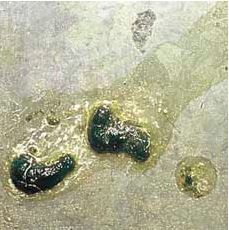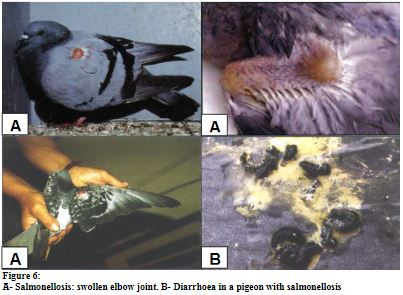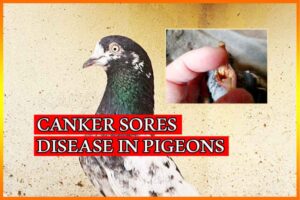Salmonella in Pigeons is a disease of birds caused by infection with Salmonella typhimurium also known as S. enterica subspecies enterica serovar Typhimurium. Salmonellosis has one of the highest mortality rates of any infectious bacterial disease of pigeons. There are more than 2,000 different species or subspecies of Salmonella found across many species of animals.

Transmission of Salmonella
Salmonellosis is transmitted by the accidental ingestion of Salmonella bacteria in contaminated food or water, and/or exposure to contaminated equipment (e.g. bird feeders). Other factors include transmission from the hen to the egg, feeding the chicks with infected crop milk and inhalation of dust containing the pathogen.
Signs For Salmonella
Acute form(mainly affects young pigeons):
Enteritis with pulpy, mucoid, greenish droppings; once organs (liver, kidneys, spleen) have become infected, there is growth retardation, emaciation and (in isolated cases) death. Embryos infected with salmonellae frequently die in ovo or during the first few days of life.

Disease of Salmonella
Inflammation causes a thickening of the joints, especially the elbow joint, wing or leg lameness, disorders of balance and torsion of the neck. Recognition of the disease: Bacteriological examination of faecal and/or organ samples.
Strategy To Prevent Loft From Salmonella
1. Keep pigeons away from wild birds, which can carry salmonella.
2. Clean and disinfect feed and water containers regularly.
3. Enclosed coops and loft areas to reduce contact with wild birds.
4. Improve ventilation in the loft area to reduce dampness and condensation, which can breed salmonella.
5. Monitor birds closely for signs of illness such as diarrhea, depression, ruffled feathers, and weight loss.
6. Consider vaccinating against salmonella if the birds will be going to shows, or live in areas of high contamination.
Treating Salmonella Poisoning
During a known outbreak of salmonellosis, remove bird feeders and baths until warmer spring weather to reduce the likelihood of transmission. Clean your bird feeders and bath two times a month with hot soapy water followed by a 3 minute soak in a 10% solution of domestic bleach (1 part sodium hypochlorite in 9 parts water) for disinfection. Clean the feeders with cold water and dry well before use.
Keep separate brushes and equipment to clean bird feeders and baths only. Keep them outside and away from food preparation areas. Wear rubber gloves when cleaning feeders and thoroughly wash hands and forearms afterwards with soap and water, especially before eating and drinking. Avoid handling sick or dead birds directly.
How Salmonella Is Treated ?
1. Isolate any affected birds.
2. Administer medication orally or by injection.
3. Provide supportive care, such as electrolyte solutions.
4. Increase the bird’s vitamin and calcium intake.
5. Provide a high-quality, nutrient-rich diet.
6. Disinfect the loft and surrounding areas.
7. Clean and disinfect drinking and feeding utensils.
8. Reduce stress levels in birds.
9. Quarantine new birds for a period of time.
10. Consider vaccinating against salmonella if the birds will be going to shows, or live in areas of high contamination.
Always start the treatment with chloramphenicol-N if the symptoms appear. In some cases it is necessary to change the treatment (e.g. todoxycyclin-torampicillin-t). Do not give pigeons any feeds containing calcium or grit during treatment withdoxycyclin-t. Since calcium binds doxycycline and thus reduces its efficacy.
In addition, If your bird is recovering from treatment of salmonella, keep his environment clean, especially food and water containers. Your bird may feel the cold with being unwell, so a little added heat may help.
Use of Multivitamin EB12 for three days during the treatment of Salmonella in pigeons is very helpful. It will help to boost the immune system of your pigeons. Use of apple cider vinegar in water is very useful.









4 Comments on “Salmonella in Pigeons – How To Disinfect Loft”